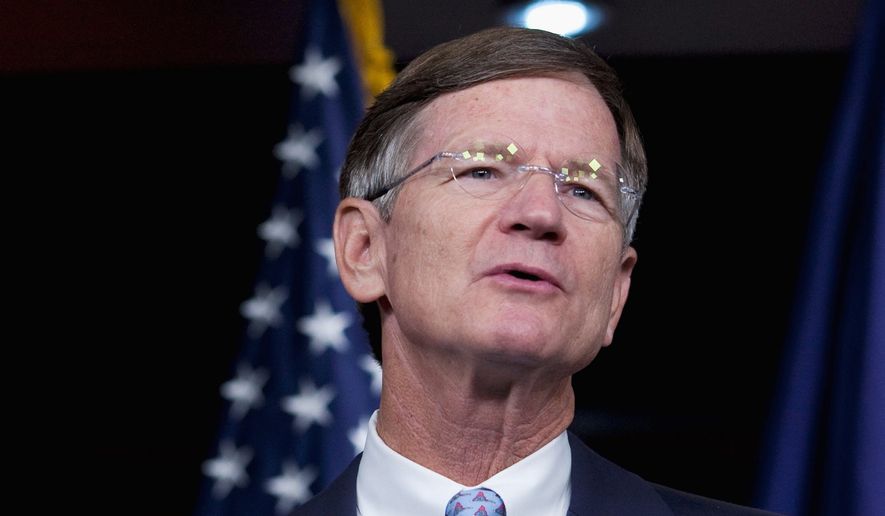It didn’t take long for Thursday’s House committee hearing on the Environmental Protection Agency’s role in blocking the Pebble Mine to start sounding less like a congressional probe and more like the plot of a Michael Crichton thriller.
Start with a proposed Alaska mine worth untold billions, add a trail of emails linking EPA staff with the mine’s opponents, and throw in an ex-agency scientist now refusing to answer questions in Australia.
“I’m just amazed. When I hear all the questions and the testimony and, quite frankly, the evidence that I’ve seen, this reads more like a novel,” said Rep. Barry Loudermilk, Georgia Republican.
At the House Committee on Science, Space and Technology hearing, Republicans took aim at the EPA’s objectivity in assessing the project, producing a cache of emails from EPA staffers obtained through Freedom of Information Act requests.
One exchange from April 12, 2009, showed EPA scientist Philip North making “suggested edits” to a draft petition drawn up by opponents of the mine calling for a review of the project under the Clean Water Act’s Section 404(c).
Another email between EPA employees David Evans and Palmer Hough referred to a press release from Sen. Lisa Murkowski, Alaska Republican, on the EPA’s decision to conduct a Bristol Bay watershed assessment.
SEE ALSO: Pebble Mine rejection by EPA was from rigging, collusion: report
“Interesting spin on EPA’s announcement/decision. Her communications would suggest no [review] would be done until all the science is in,” Mr. Evans wrote in the Feb. 7, 2011, email. “Obviously, that’s not what we have in mind.”
Rep. Gary J. Palmer, Alabama Republican, called the email “just another example of the EPA working outside acceptable parameters, overreaching and, in some cases — and in this case — it just appears to be very manipulative of the process to reach a predetermined outcome.”
“We’ve seen it in other areas where the EPA’s involved — the ozone standard, the Clean Power Plan, the waters of the United States and now with Pebble Mine. I just think at some point EPA’s got to be held accountable for actions such as this.”
House Democrats pointed out that no EPA officials were present at the hearing, but Chairman Lamar Smith, Texas Republican, said they had been invited to an upcoming hearing in order to avoid problems with ongoing litigation.
They argued that the EPA had little choice but to act given the outcry from opponents in Alaska, including some tribes and owners of nearby sockeye salmon fisheries, and the refusal by the Pebble Partnership to file for a mining permit.
“How much of EPA’s decision to move forward was based on frustration that emerged from the fishermen who depend on this, from the Native Americans, from the people of Alaska, that this was just a sword of Damocles hanging over their head?” said Rep. Donald S. Beyer Jr., Virginia Democrat. “That Pebble was not coming forward with a mine permit and there was a lot of pressure on the EPA to do something?”
Former Defense Secretary William Cohen, author of an Oct. 6 report critical of the process, pointed out that the project lies on state land designated for mining, not federal land.
“The notion that the EPA can make you file something that you’re not ready to file, and over the objections of the state of Alaska, is, it seems to me, that’s quite a stretch for EPA’s power,” Mr. Cohen said.
The report by Mr. Cohen, who was in Democratic President Clinton’s cabinet, concluded that the EPA had acted unfairly by using the less comprehensive 404(c) authority instead of evaluating a permit application under the National Environmental Policy Act.
“EPA’s unprecedented, preemptive use of Section 404(c) before a permit filing, in my judgment, exacerbated the shortcomings of the Bristol Bay Watershed Assessment and inhibited the involvement of two key participants — the Army Corps of Engineers and the State of Alaska,” Mr. Cohen said in his testimony.
His findings were echoed in a report released Wednesday by the House Committee on Oversight and Government Reform, which accused the EPA of exercising a “preemptive veto” against the mine by undertaking a rarely used 404(c) review.
The report cites a 2010 email in which Mr. Hough, an environmental scientist in the EPA’s wetlands division, says that, “we have never gone down the route of a ’preemptive’ 404(c) action before.”
Former Alaska Senate President Rick Halford defended the process, testifying that “as a resident of Bristol Bay, I can tell you that nothing seems predetermined to me in EPA’s actions.”
“EPA collected information and data, met with and listened to both sides and engaged in extensive outreach to all the stakeholders,” Mr. Halford said. “I do not believe that EPA’s engagement itself was out of the ordinary as it is common for developers and the public to seek EPA’s perspective in advance of formal project initiation.”
Tom Collier, CEO of the Pebble Limited Partnership, said the EPA should have waited until the company submitted a permit application for the mine project before moving forward with incomplete data in its proposed July 2014 regulations.
“What’s going on here is that EPA is drafting the petitions that they said were then the reason why they launched the process against us. I mean, that’s poppycock,” Mr. Collier said. “They launched this process against us because they always planned to kill this project. Particularly Phil North. He’s helping draft the petitions that he then said were the reasons why he initiated this process.”
“So it’s not just that they were working together, they then misled the rest of us about why they moved forward with this proposed veto,” Mr. Collier said.
Mr. Cohen said that Mr. North also sent emails on the issue from his private email account. Now retired and living in Australia, Mr. North has “refused to respond to requests to meet with him talk to him,” said Mr. Cohen.
• Valerie Richardson can be reached at vrichardson@washingtontimes.com.




Please read our comment policy before commenting.